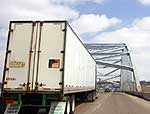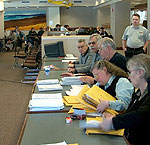By Mary Losure
Minnesota Public Radio
April 8, 2002
Almost everyone agrees the state's traffic congestion is worsening. Some people think we should add new lanes to freeways, others say widened roads will soon be clogged with traffic, and mass transit needs to be a major part of the solution. But regardless of who's right, Minnesota's system for funding transportation is heavily weighted in favor of more highways.
| |
|
|
|
||
In the Minnesota Department of Transportation's sunlit cafeteria, more than 100 contractors sit hunched over cups of coffee, listening intently as they compete for more than $17 million worth of road projects.
The projects' funding is guaranteed, thanks to a provision in the state's Constitution requiring that highway projects receive all the money from the state's gas tax and license tab fees; last year that was more than $1 billion - a sum that's been mounting steadily over the past decade.
It's rising because motorists are driving more and more miles in larger, more expensive, and less fuel-efficient vehicles.
The more people drive their SUVs, the more money goes into the gas tax fund, and thus into highways. By law, none of those dollars can be used for used for transit projects.
Barb Thoman, of the advocacy group Transit for Livable Communities, says that "highways-only" approach hasn't changed since the state Constitution was last amended, nearly a half century ago.
"I would wonder if it still makes sense for us to distribute our transportation dollars in 2001 the same way we did in the 1956. Minnesota looks very different today than it did in 1956," Thoman said.
Thoman says in some places, the best way to relieve congestion may be additional busses or a light rail system, instead of a new highway lane, but she's one of the few voices at the state Capitol making that argument, and her group is hugely outgunned by the road-building lobby.
|
"We that think that the public is way ahead of the Legislature on this issue... they want alternatives."
- Fred Corrigan, lobbyist for the Minnesota Transportation Alliance Listen to more |
That lobby includes construction companies, concrete and asphalt manufacturers, and county and township governments. In the state's last fiscal year, they spent more than $300,000 lobbying at the state Capitol. Transit for Livable Communities spent a total of $712.
Thoman says the idea of changing the current formula to give transit projects some of the revenue now flowing into highways is not even under consideration. "I think people are terrified of the idea. I think elected officials are terrified of the idea of suggesting that we could actually substitute some transit projects for road projects," she says.
So transit advocates have tried to find other funding sources, outside the billion-dollar highway fund.
Carol Flynn, a retired state senator from south Minneapolis, who formerly headed the Senate Transportation Committee, says the main hurdle has been convincing rural legislators like House Speaker Steve Sviggum to approve money for what they see as an urban need.
"Sviggum has said he's been over in St. Paul and watched these empty busses going around, so why should we put any more money into that? My comeback to him has always been: I've driven by your farm and you have fewer cars going by your farm than I do in the alley behind my house. He just chooses to make that argument because busses won't do his constituents any good, from his perspective," according to Flynn.
| |
|
|
|
||
Flynn and other transit supporters have tried for years to get transit projects a reliable, dedicated source of funding similar to that enjoyed by highways, but without success. That failure means all transit projects have to go back to the state Legislature for money every one or two years.
Minnesota Transportation Commissioner Elwyn Tinklenberg says that makes it hard to do the long-term planning needed for an integrated system of transit and highways. He says it also hurts Minnesota's chances of getting federal funding for projects like light rail, and puts the long-term future of a successful transit system in doubt.
"I think there are some folks who would like to see that, who believe that transit isn't serving an adequate purpose, that it spends too much money or and it costs too much; they want the money to go into highways, and so by just parceling it out little bit by little bit it keeps us from doing the kinds of major improvements that will really make it work," Tinklenberg says.
Three years ago, lawmakers narrowly agreed to continue funding for Minnesota's first light-rail line, the Hiawatha project between downtown Minneapolis and the International airport, but the bitterly contested bill passed only under intense pressure from Gov. Jesse Ventura.
Last session, transit opponents tried unsuccessfully to pass a measure requiring business along the light-rail line to pay higher property taxes to subsidize its operating costs. But some say those kinds of fights may be rarer in the future.
Fred Corrigan, a long-time lobbyist for the Minnesota Transportation Alliance, which includes traditional transit foes such as the Highway Construction Industry Council, says members, who once argued any money for transit was a loss to highways, have softened their stance. Now, Corrigan says the Alliance supports the idea of a steady, reliable source of transit funding.
"We that think that the public is way ahead of the Legislature on this issue. That they want to make increased investments in transportation, they want to see a more diverse and flexible system, they want alternatives," according to Corrigan.
Some companies now see a transit as a business opportunity.
"From the construction standpoint, the same people that build the highways are going to be the same people that build the transit systems, the light rails and all that. We want a product that's a good product, and that people want," says Richard Thomas, a lobbyist for Ames Construction, the state's largest transportation construction firm.
Thomas says in some congested urban corridors, neighborhood opposition and huge costs make it impossible to add highway lanes.
The right-of-way costs for widening a corridor - such as 35W in Minneapolis - would be staggering. Added to that would be the expense of re-doing bridges and interchanges.
"To give you an example, just the 494-35W interchange, you're probably talking about a $1 billion project if you were to redo that," according to Thomas.
Transit supporters argue that trying to solve metro area congestion problems solely with more highways will suck up huge amounts of money, at the expense of outstate roads.
But House Speaker Steve Sviggum is not convinced. "Transit does have to be part of the mix, there's no doubt. But let's look at what we've done with the last transit, the light-rail transit - $800 million, probably. It's not going to relieve any congestion on the roads," says Sviggum.
Sviggum says Minnesota needs to focus its efforts on increasing the capacity of its highway system. But he says road and bridge interests now realize that bills without any funding for transit won't pass, so the key to moving forward is finding a balance between the two.
More from MPRMore Information


